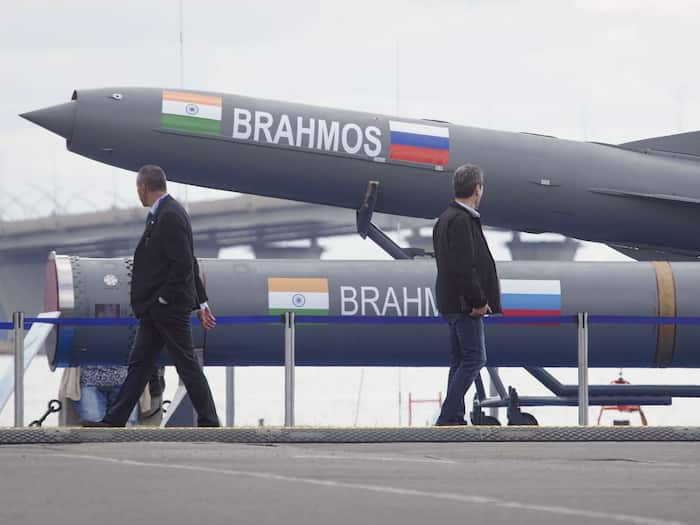The BrahMos and Tomahawk represent two fundamentally different approaches to deterrence. Think of it as the difference between a charging rhino and a prowling panther.

Which missile truly rules the waves of modern warfare – India’s lightning-fast BrahMos or America’s stealthy Tomahawk?
In the high-stakes chess game of global defence, two missiles have emerged as the ultimate power pieces: India’s supersonic BrahMos and America’s subsonic Tomahawk. After decades of American dominance in cruise missile technology, a new challenger has not just entered the arena—it has blazed through it at three times the speed of sound.
The recent Operation Sindoor gave the world a brutal demonstration of what happens when unstoppable force meets inadequate defence. When Indian BrahMos missiles struck Pakistani airbases with surgical precision—leaving even China-supplied air defence systems helpless—it wasn’t just Pakistan that took notice. Defence planners from Manila to Riyadh began rewriting their assumptions.
The Tale of Two Philosophies
The BrahMos and Tomahawk represent two fundamentally different approaches to deterrence. Think of it as the difference between a charging rhino and a prowling panther.
BrahMos: The Supersonic Sledgehammer
At Mach 2.8 to 3.0, the BrahMos travels nearly three times faster than subsonic missiles like the Tomahawk. Being twice as heavy and almost four times as fast, it delivers over 32 times the on-cruise kinetic energy of a Tomahawk. When BrahMos hits, it doesn’t just explode—it pulverises.
Its 99.99% strike accuracy, combined with blistering speed, creates a nightmare scenario for enemy defences. Pakistan’s admission that it had only 30 to 45 seconds to assess whether the BrahMos carried a nuclear warhead reflects the psychological impact of this weapon.
Tomahawk: The Stealthy Stalker
With a range of up to 2,400 km and a subsonic speed of 885 km/h, the Tomahawk makes up for its slower velocity by flying at ultra-low altitudes, evading radar.
Its strength lies in loitering capabilities—providing real-time battle updates, switching targets mid-flight, and waiting for optimal strike conditions. It’s a surgical scalpel—patient, precise, and persistent.
Range: The Great Divide
The Tomahawk’s long reach (1,600–2,400 km) supports intercontinental strategy, neutralising threats far beyond immediate borders. BrahMos, in its standard 290–450 km variant, reflects India’s regional focus.
However, the upcoming BrahMos-LR (800 km range) will bridge this gap within two to three years. In places like the South China Sea, even the current BrahMos variant is enough to dominate regional EEZs.
Combat Pedigree: Proven vs Battle-Tested
The Tomahawk has a rich combat legacy—over 2,300 missiles fired since 1991 in conflicts like the Gulf War, Syria, and Yemen.
BrahMos has now earned its combat stripes. Pakistan’s Prime Minister publicly acknowledged that BrahMos missiles struck strategic military locations including Rawalpindi Airport and Nur Khan airbase, and not a single missile was intercepted.
The Export Revolution
India is targeting USD 5 billion (approx. Rs. 41,750 crore) in annual defence exports by 2025—and BrahMos is its spearhead. The Philippines signed a USD 375 million (approx. Rs. 3,130 crore) deal. Vietnam is close to USD 700 million (approx. Rs. 5,845 crore), while Indonesia is negotiating $450 million (approx. Rs. 3,755 crore). Interest spans across Southeast Asia, South America, and the Middle East.
By contrast, the Tomahawk remains exclusive to America’s closest allies due to ITAR restrictions and technology sensitivity.
Cost Mathematics
- Tomahawk: USD 1.99 million (approx. Rs. 16.6 crore)
- BrahMos: USD 3–4 million (approx. Rs. 25–33.4 crore)
Despite the higher price tag, the cost-effectiveness of BrahMos lies in its near-zero interception risk and one-shot-one-kill precision.
The Deterrence Verdict
For Regional Deterrence: BrahMos Wins
For countries facing immediate threats, BrahMos delivers swift, overwhelming, and unchallengeable response capability. Its presence alone reshapes the enemy’s calculus.
For Global Power Projection: Tomahawk Leads
Tomahawk is built for extended campaigns, offering long-range reach, retargeting flexibility, and mission endurance—ideal for America’s worldwide commitments.
The Future Landscape
The missile race is heating up:
- BrahMos-II: 1,500 km range, Mach 8, expected soon
- Supersonic Tomahawk: Under development with ramjet tech to reach Mach 3
The Strategic Implications
This isn’t just an arms race—it’s a reordering of global defence power. The BrahMos shows that indigenous systems from emerging powers can now challenge Western monopolies.
For decades, U.S. allies relied on Washington for cutting-edge arms. Today, countries from Vietnam to Egypt are embracing a new supplier—India—without the political baggage.
The Bottom Line
There is no single winner in this duel. It’s about context.
- Need rapid, devastating, hard-to-stop regional dominance? Choose BrahMos.
- Need long-range, flexible, stealthy strike tools? Choose Tomahawk.
But the real shift is that nations now have a choice. The BrahMos has opened the door to a multipolar missile market.
In this new era, the smart defence planner won’t ask which missile is best. They’ll ask: Which missile suits my battlefield best?
(Girish Linganna is an award-winning science communicator and a Defence, Aerospace & Geopolitical Analyst. He is the Managing Director of ADD Engineering Components India Pvt. Ltd., a subsidiary of ADD Engineering GmbH, Germany. Contact: girishlinganna@gmail.com )
Also Read:




















































